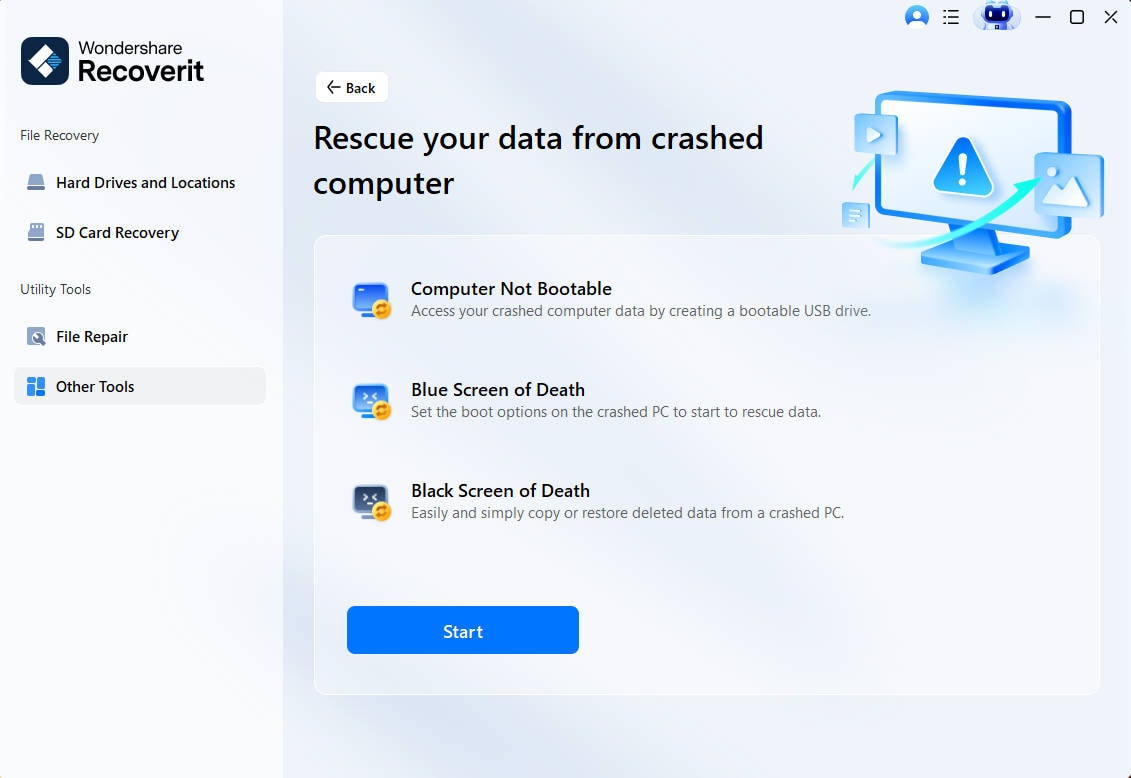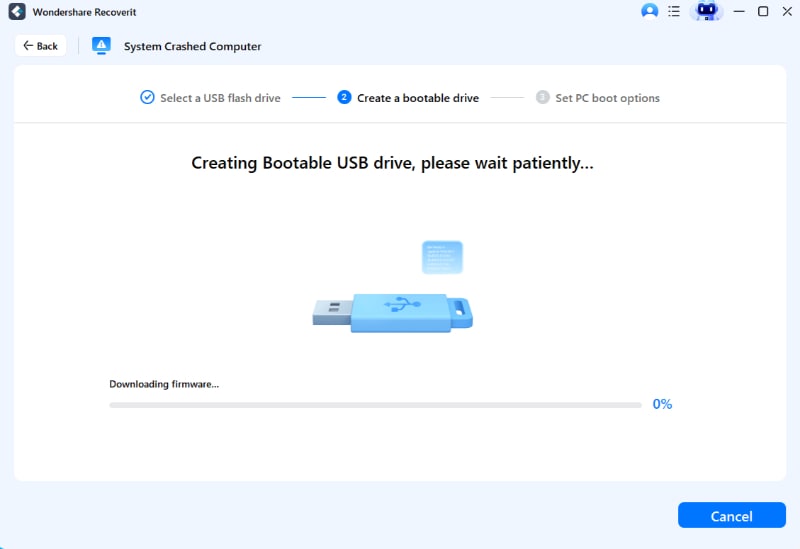Getting the Windows Boot Manager Failed error can stop your computer from starting up, which means you can't get to your operating system. This problem typically stems from corrupted system files, defective hardware, or incorrect system configuration. Restoring your system's normal functionality requires you to know how to diagnose and fix this problem.
Different ways, such as startup repair, command prompt tools, and reinstalling the boot manager, will be looked at in this guide on how to fix Windows Boot Manager errors. These steps will help you troubleshoot and fix the problem quickly, ensuring that your PC is back up and running smoothly whether you are a tech-savvy beginner or not.
Try Wondershare Recoverit to Perform Windows Data Recovery

In this article
Part 1: What is Windows Boot Manager?
The Windows Boot Manager (BOOTMGR) is a crucial part of the operating system that is responsible for starting the Windows operating system startup process. It loads the boot configuration data and operating system files to make sure that your PC starts up properly. Your computer would have trouble finding and loading the necessary files to boot up Windows without it. A crucial component of the operating system's boot process, the Boot Manager connects your hardware to the operating system.
However, when issues like Windows Boot Manager failed, they can prevent the operating system from loading altogether. This could be a result of corrupted boot files, misconfigured settings, or broken hardware. Understanding the function of the Windows Boot Manager error troubleshooting is crucial for resolving such issues. Your system will run smoothly and avoid major errors that could cause system crashes or boot failures if boot manager issues are resolved.

Part 2: Why did Windows Boot Manager Boot Failed?
This means there is a major problem with your system's startup when you see the message that Windows boot failed to start. This issue frequently prevents users from accessing their operating system, halting the system and causing frustration. A number of factors can cause this error, and finding the root cause is important for fixing it properly. A Windows Boot Manager boot failed error usually means one of a few things.
1. Corrupted System Files
System files are very important for Windows to load correctly. The Windows boot failed to start error can show if malware, unexpected shutdowns, or bad Windows updates corrupt these files. A system file check or startup startup repair can frequently fix this.
2. Improper Boot Configuration
Your system may be prevented from locating the required files to boot by incorrect settings in the BIOS or Boot Configuration Data (BCD). The problem can be fixed by changing these settings manually or using configuration repair tools.

3. Damaged Boot Disk
The boot manager may have trouble finding the files required to load Windows if the hard drive or SSD that stores your operating system is damaged or failing. This means that hardware replacement or disk repair might be needed.
4. Missing or Misconfigured Boot Manager
A Windows Boot Manager boot failed error can be caused by a boot manager that is missing or improperly configured. If the boot manager files were deleted, overwritten, or set up wrong during system configuration, this could happen. Most of the time, this problem can be fixed by reinstalling or reconfiguring the boot manager with advanced boot tools.
Part 3: How to Fix Windows Boot Manager?
Experiencing problems with boot manager not working can make it difficult for your computer to start up. Corrupted files or incorrect configuration are frequently the cause of this common issue. Boot manager not working and the issue fixing process may cause data loss on your computer. First of all, dowload Recoverit to recover and save your important files form your computer.
Fix 1: Use Wondershare Recoverit
Wondershare Recoverit is a potent data recovery tool designed to assist you in recovering files even if your computer won't boot. When you get an error stating that Windows Boot Manager Windows failed to start 0xc00000f, Recoverit can help by making a bootable USB drive on a computer that is already working.
The non-booting PC is then started using this USB drive, enabling safe data recovery without further damage. You can back up your important files with Recoverit even if the system won't start up. This makes it an important tool for anyone who has to deal with boot errors and system failures.
Steps:
- Download and install Wondershare Recoverit on a working computer to begin the data recovery process.

- Launch the tool and select "Recover from Crash Computer" on the main screen. Connect your USB drive to the PC.
- In the next window, choose "Create USB Bootable Drive" and click "Create" in the bottom-right corner.

- Click "Format Now" to format the flash drive quickly and prepare it for creating the bootable drive.

- Allow the software to create the bootable USB. Do not interrupt the process to avoid restarting.

- Restart your non-booting PC, adjust the BIOS to boot from USB, and follow the on-screen instructions to recover data.

- By using Recoverit software, you can recover all of your files.

Learn more >>:
How to Fix Invalid Partition Table?
Fix 2: Use the Bootrec.exe Tool
When the Windows Boot Manager fails, it's usually because the Boot Manager is damaged, causing errors like "BOOTTMGR is missing". Seeing these signs can help you confirm the problem. The Windows Recovery Environment (RE) has a repair tool called Bootrec.exe that you can use to fix this. Below is a step-by-step guide on how to use Bootrec.exe to repair the Boot Manager and restore your system.
Steps:
- Start your computer using the Windows installation media, such as a USB or DVD.
- Choose your language, time format, and keyboard method, then click "Next".
- Select "Repair Your Computer", then click "Troubleshoot" from the options.
- Click on "Advanced Options", then select "Command Prompt".

- Enter the commands bootrec.exe /fixmbr, bootrec.exe /fixboot, and bootrec.exe /rebuildbcd, pressing "Enter" after each to repair the Boot Manager and rebuild the BCD. Remove the media and restart your computer.

Fix 3: Apply Disk Partitioning Freeware
For optimal storage management on your hard drive, disk partitioning is a must. Users can better organize data and enhance performance by splitting a single physical drive into multiple logical drives. However, poor partitioning can cause problems like Windows boot failed to start, which prevents access to files. If you know how to properly split your drive, you can avoid these kinds of problems and make your system run better.
Steps:
- Right-click the Start button and select "Disk Management", or press the Windows key + X and choose "Disk Management" from the menu.

- In the Disk Management window, identify the physical drive you wish to partition from the list of available drives.
- Right-click on the existing volume you want to shrink, select "Shrink Volume", then enter the amount of space to shrink in MB and click "Shrink".
- Right-click the unallocated space and select "New Simple Volume". Follow the wizard to choose the volume size, assign a drive letter, and format the partition.

- Click "Finish" to finalize the creation of your new partition, making it ready for use.
Fix 4: Update Your BIOS or UEFI
Updating the BIOS or UEFI files is essential to ensure compatibility if you recently upgraded your processor. If you don't, you might get the Windows Boot Manager boot failed error, which will stop your system from starting normally. Always reinstall the old processor to get updates, and make sure you have a backup of your info in case you lose it during this process.
Steps:
- Open the Microsoft Store and search for "MSI Center".

- Click the "Get" button to download the application. Once installed, navigate to Support and select Advanced Options.

- Choose the BIOS update option and wait for the process to complete. Remember, updating BIOS or UEFI carries risks; ensure you follow the instructions carefully to avoid potential issues.
Fix 5: Perform Automatic Repair
If the Windows Boot Manager fails to start, the error shows up; you can fix it with Windows Automatic Repair. You'll need Windows installation media, like a USB flash drive or CD/DVD, to start this process. You can make a bootable USB drive with tools like RUFUS if you don't already have one. When you follow the on-screen instructions, Automatic Repair will start and fix the problem.
Steps:
- Use Windows Installation Media to start your computer.

- At the initial screen, choose your language, time zone, and other preferences, then click "Next".

- Click "Repair Your Computer" in the bottom-left corner, then select "Troubleshoot" and go to "Advanced Options".

- Select "Startup Repair" and follow the on-screen instructions to repair your system successfully.
Fix 6: Perform a System Restore
You can restore your computer to a previous state or restore point without having to reinstall the Microsoft operating system with the help of System Restore, a useful Windows utility. This feature can be especially useful when facing issues, such as the Windows Boot Manager Windows failed to start 0xc00000f error, helping to resolve problems caused by install failures or data corruption.
Steps:
- Select the Start button, type "control panel" in the search box, and choose "Control Panel (Desktop app)" from the results.

- In the Control Panel, search for "Recovery", then select "Recovery" and click on "Open System Restore".

- Choose the restore point associated with the problematic app, driver, or update, then click "Next" and "Finish" to complete the restoration process.
Fix 7: Edit Windows Boot Manager
The Windows Boot Manager operating system can occasionally become damaged or corrupted, causing problems with booting. You might be able to fix problems like a broken boot configuration or the wrong start order by editing the Windows Boot Manager configuration. The following steps should be taken to edit the Windows Boot Manager step:
Steps:
- Run your system using Windows installation media.
- Choose your language, keyboard/input method, and time format, then click "Next".
- Select "Repair Your Computer", then navigate to "Troubleshoot" using the arrow keys.

- Choose "Advanced Options", then select "Command Prompt".
- Enter "bcdedit /?" to view commands for editing and "bcdedit /default" to set the default entry.

Part 4: How to Troubleshoot Windows Failed to Start?
When your computer has problems and displays the "windows boot manager failed to start" message, it could be because of a corrupted Boot Manager issue. To restore your system, it is essential to know how to troubleshoot this issue. When dealing with this issue, the following are some effective steps.
1. Use Startup Repair
Using a Windows Installation Media USB (or DVD), boot your computer. Click "Repair your computer" and then go to "Startup Repair" under "Troubleshoot" and "Advanced options". This tool automatically scans for and fixes common startup problems.
2. Check Hardware Connections
Startup failures can occasionally be brought on by damaged or loose hardware. For hard drives and cables, make sure that all internal and external connections are safe. Remove and reseat any necessary parts, such as RAM and graphics cards.
3. Run System Restore
Use System Restore to revert your system to a previous state if the problem still exists. By booting from the installation media, picking "Repair your computer", and then selecting "System Restore", you can get to this. If the Windows Boot Manager didn't work after recent updates or software installations, this can help.
Conclusion
In conclusion, knowing how to fix Windows Boot Manager issues is essential for maintaining your computer's functionality. You can effectively handle startup problems by using effective troubleshooting steps like Startup Repair, checking hardware connections, and System Restore. Remember to regularly back up your info so that you don't lose it while you're troubleshooting. You can restore your system and make sure it boots smoothly with the right method, allowing you to get back to work without any problems.
Try Wondershare Recoverit to Perform Data Recovery

FAQ
-
How do I fix system boot failure?
Before you try to fix a system that won't boot, make sure that all of the hardware connections are safe. You can get to the repair choices with recovery media; just choose "Startup Repair." When Windows boot manager failed to start due to corrupted configuration or incorrect settings, this process frequently fixes the issue. -
How do I fix a computer that failed to boot?
Try booting into Safe Mode by hitting F8 during startup if your computer won't start. You can then troubleshoot drivers and software problems from there. To reach recovery options and, if necessary, repair the boot process, use the installation media instead. -
How do I repair my computer startup?
Boot from the Windows installation media and choose "Repair your computer startup" to repair your computer's startup. To fix the startup, go to "Troubleshoot" > "Advanced options" > "Startup Repair." This tool helps fix common startup issues, especially when the Windows Boot Manager boot failed due to system file corruption or configuration.




 ChatGPT
ChatGPT
 Perplexity
Perplexity
 Google AI Mode
Google AI Mode
 Grok
Grok























